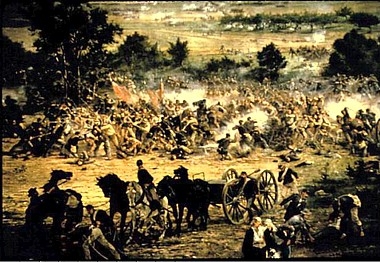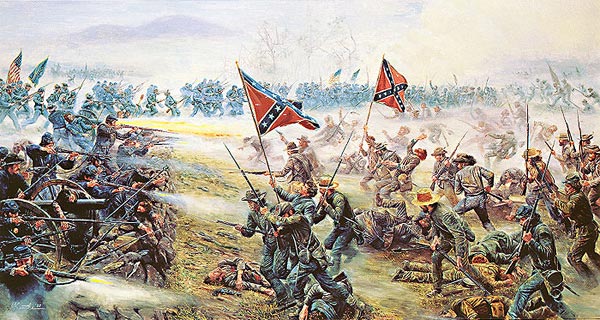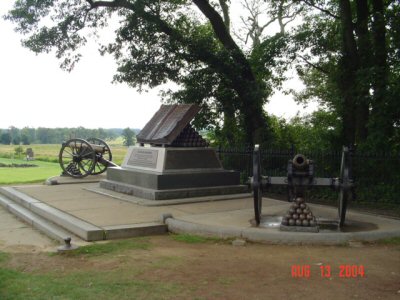AMERICA’S “LOVE BATTLE”

“The Battle of Gettysburg”, painted in 1884 by French artist Paul Dominic Philippoteaux. This spectacular scene from the Gettysburg Cyclorama, is the artist’s impression of Armistead’s attack into the Angle, the Confederacy’s “High water mark.”
The great English writer Robert Graves wrote in his masterpiece Goodbye To All That about the battles of World War I at the Somme and Passchendaele being “Love Battles.” Graves reasoned that only men with an unquestioning and sublime love of country could have participated in those attacks where so many were uselessly slaughtered.
In 1863, mankind had yet to perfect the instruments of war that resulted in the kind of mass butchery which occurred on the Western Front during World War I. But it wasn’t for lack of trying. The Civil War saw so many “innovations” in the art of war - first widespread use of rifled muskets, first widespread use of trench warfare, first use of balloons for artillery spotting, to name a few - that it can fairly be said that what happened on the battlefields in America during that conflict was a preamble to the hell endured by soldiers during the Great War just a few generations later.
The 50,000 men who were killed and wounded at Gettysburg had the kind of “love” written about by Graves. Perhaps no generation in American history ever believed in things like “country” and “patriotism” so deeply. The Federals proved it at the battle of Fredericksburg, Virginia in December of 1862 when 20,000 fell in one day as regiment after regiment marched toward a stone wall on Marye’s Heights only to be butchered by Southern riflemen. All day long the slaughter went on. Each new formation sent against those heights knew full well what was in store for them. And yet, they made those futile charges one after another until even many of their enemies began to feel sorry for them.
Of course, Pickett’s Charge contained many of the same elements. Every one of those 12,000 Southerners knew what it meant to walk across 8/10 of a mile of open ground under the Federal’s guns for the entire advance and the massed rifles of infantrymen during the final few hundred yards. These were hardened veterans who were used to sizing up advances like this and coldly calculating the odds of success. The fact that many of them sowed pieces of paper on their uniforms with their names and hometowns on it in case no one could identify their mangled bodies after the battle says volumes about what the soldiers thought about their participation in that famed attack.

“High Water Mark” by Mort Kunstler.
Then why did they do it?
A large part of the reason was their love and respect for the soldier next to them in line. They didn’t want to appear cowardly nor did they want to let their comrades down in the heat of battle. But certainly there was also a dead serious belief that what they were doing was right. And, in this particular battle, there was the very real prospect of ending the war in victory. General Armistead was heard shouting as he got to The Angle at Cemetery Hill “Home boys…Home is over this hill.” That too, must have been a powerful incentive.
But at bottom, Gettysburg revealed all the South’s hopes for victory to be illusory. Most military historians have criticized Lee for even attempting the attack on the Union center that fateful July 3rd. They point out that even if he had succeeded in piercing the Union lines, there would have been precious few Southerners left standing to exploit the breach and split Meade’s army in two which was Lee’s goal in ordering the attack. All the attack succeeded in doing was adding to the massive butcher’s bill for the three days where the two great armies met to decide the fate of the country.
William Faulkner touches on this theme of southern illusions in his book Intruder in the Dust when he wrote that every southern boy who grew up after Gettysburg was allowed the dream of southern triumph by imagining themselves on Cemetery Hill with Armistead at the confederacy’s high water mark. In their dreams, they would break through the line of Federals and carry the South to victory. Faulkner used this allegory to describe much of the hopelessness he saw in southern whites of the 20’s and 30’s who were beaten down by poverty and tradition while tainted with the legacy of slavery and racism.
Meade’s failure to follow up on his victory by either immediately attacking or pursuing and trapping the Southern army against a swollen Potomac river before it could escape is to my mind the greatest “What If” of the battle. Although it’s unlikely that Jefferson Davis would have surrendered even if he lost the Army of Northern Virginia, the heart would have gone out of the rebellion and, coupled with Grant’s victory at Vicksburg, would have placed the South in a similar strategic position it eventually found itself in April of 1865. Only the trans-Mississippi states of Texas and Arkansas would have been able to resist Federal troops.
That said, the one big southern counter factual must be Ewell’s failure to take Cemetery Ridge on the first day of the battle. He was ordered by Lee to take those hills “if practicable.” The fact that he didn’t has been the subject of endless argument and speculation since the battle ended. One wonders if Stonewall Jackson had still be in command of that Corps, would he have hesitated. If the South had taken the heights outside of town, it would have been northern boys making that long march under the hot sun toward Cemetery Hill and destiny.

“HIGH WATER MARK” MONUMENT AT GETTYSBURG
So ends this experiment in blogging. I realize I took massive liberties with the concept as much of what I wrote wasn’t discovered until many days and weeks after the battle was over. But I’ve rarely had so much fun. The idea of transporting oneself back in time to be an eyewitness to a great event was fascinating.
And thanks all for your wonderful comments and emails. I hope you learned as much as I did. I’ll leave you with a verse from one of the great anti-war poems of all time; Wilfred Owen’s “Anthem for a Doomed Youth.”
What passing-bells for these who die as cattle?
Only the monstrous anger of the guns.
Only the stuttering rifles’ rapid rattle
Can patter out their hasty orisons.
No mockeries now for them; no prayers nor bells,
Nor any voice of mourning save the choirs,–
The shrill, demented choirs of wailing shells;
And bugles calling for them from sad shires.
Thank you for this wonderful history lesson!
I have always found it amazing that General Robert E. Lee, arguably the greatest battlefield commmander in American military history, pulled arguably the biggest blunder in American battlefield history with his ill-advised assault on the Union center with General George Pickett’s division.
But perhaps the divine hand of providence was at work, as it would be 78 years later when a softspoken Texan elevated over 18 superior ranking flag officers would emerge from the smoky catastrophe of Pearl Harbor to send that entire Japanese task force to the bottom of the Pacific Ocean six months later in the Battle of Midway.
Chester W. Nimitz went on to become America’s greatest Admiral. The Battle of Midway remains the finest hour in the history of the United States Navy.
But back to providence…
As the Army of Northern Virginia withdrew south to the safety of the Shenandoah, its veneer of invincibility shattered forever, the sun rose on a new day.
July 4, 1863.
The day America turned four score and seven years old.
God bless you for this history lesson.
God bless America, 229 years young.
Sincerely,
Brian Golden
Lancaster, California 93550
Comment by Brian Golden — 7/4/2005 @ 1:15 am
Rick…
Simply marvelous. Don’t have enough superlatives in my Thesaurus to tell you what a great job you did and how much I enjoyed it. Thanks so much for all your hard work.
Comment by greg — 7/4/2005 @ 7:23 am
[...] IZBANG WUZZADEM
WELCOME HUGH HEWITT READERS!A FORGETTABLE, EDIBLE FOURTHJULY 3, 1863AMERICA’S “LOVE [...]
Pingback by Right Wing Nut House » WELCOME HUGH HEWITT READERS!: Politics served up with a smile… And a stilletto. — 7/4/2005 @ 12:09 pm
pedantry on/ I believe the explanation of Southern character you attribute to O’Connor is actually from Faulkner./pedantry off
A great article.
Comment by Sal — 7/9/2005 @ 7:06 am
The Council Has Spoken!
First off… any spambots reading this should immediately go here, here, here, and here. Die spambots, die! And now… the winning entries in the Watcher’s Council vote for this week are Border Freebies: Using the Race Ca…
Trackback by Watcher of Weasels — 7/9/2005 @ 11:54 pm